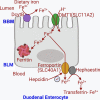Polycystic ovary syndrome and iron overload: biochemical link and underlying mechanisms with potential novel therapeutic avenues
- PMID: 36408981
- PMCID: PMC9867939
- DOI: 10.1042/BSR20212234
Polycystic ovary syndrome and iron overload: biochemical link and underlying mechanisms with potential novel therapeutic avenues
Abstract
Polycystic ovary syndrome (PCOS) is an endocrine and metabolic disorder in women with components of significant genetic predisposition and possibly multiple, but not yet clearly defined, triggers. This disorder shares several clinical features with hemochromatosis, a genetically defined inheritable disorder of iron overload, which includes insulin resistance, increased adiposity, diabetes, fatty liver, infertility, and hyperandrogenism. A notable difference between the two disorders, however, is that the clinical symptoms in PCOS appear at much younger age whereas they become evident in hemochromatosis at a much later age. Nonetheless, noticeable accumulation of excess iron in the body is a common finding in both disorders even at adolescence. Hepcidin, the iron-regulatory hormone secreted by the liver, is reduced in both disorders and consequently increases intestinal iron absorption. Recent studies have shown that gut bacteria play a critical role in the control of iron absorption in the intestine. As dysbiosis is a common finding between PCOS and hemochromatosis, changes in bacterial composition in the gut may represent another cause for iron overload in both diseases via increased iron absorption. This raises the possibility that strategies to prevent accumulation of excess iron with iron chelators and/or probiotics may have therapeutic potential in the management of polycystic ovary syndrome.
Keywords: bacterial dysbiosis; hemochromatosis; hepcidin; iron overload; polycystic ovary syndrome; probiotics.
© 2022 The Author(s).
Conflict of interest statement
The authors declare that there are no competing interests associated with the manuscript.
Figures



Similar articles
-
Role of decreased circulating hepcidin concentrations in the iron excess of women with the polycystic ovary syndrome.J Clin Endocrinol Metab. 2011 Mar;96(3):846-52. doi: 10.1210/jc.2010-2211. Epub 2011 Jan 5. J Clin Endocrinol Metab. 2011. PMID: 21209031 Clinical Trial.
-
miR-761-hepcidin/Gpx4 pathway contribute to unexplained liver dysfunction in polycystic ovary syndrome by regulating liver iron overload and ferroptosis.Gynecol Endocrinol. 2023 Dec;39(1):2166483. doi: 10.1080/09513590.2023.2166483. Epub 2023 Jan 19. Gynecol Endocrinol. 2023. PMID: 36657482
-
[Genetic iron overloads and hepatic insulin-resistance iron overload syndrome: an update].Rev Med Interne. 2009 Jan;30(1):35-42. doi: 10.1016/j.revmed.2008.05.004. Epub 2008 Jun 26. Rev Med Interne. 2009. PMID: 18584923 Review. French.
-
Review article: the iron overload syndromes.Aliment Pharmacol Ther. 2012 Apr;35(8):876-93. doi: 10.1111/j.1365-2036.2012.05051.x. Epub 2012 Mar 4. Aliment Pharmacol Ther. 2012. PMID: 22385471 Review.
-
Iron metabolism and the polycystic ovary syndrome.Trends Endocrinol Metab. 2012 Oct;23(10):509-15. doi: 10.1016/j.tem.2012.04.003. Epub 2012 May 10. Trends Endocrinol Metab. 2012. PMID: 22579050
Cited by
-
Sigma Receptors: Novel Regulators of Iron/Heme Homeostasis and Ferroptosis.Int J Mol Sci. 2023 Sep 28;24(19):14672. doi: 10.3390/ijms241914672. Int J Mol Sci. 2023. PMID: 37834119 Free PMC article. Review.
-
Lipidomics Reveals Common Mechanisms in Polycystic Ovarian Syndrome, Recurrent Spontaneous Abortion, and Infertility: A Genetic-Based Analysis.Int J Womens Health. 2025 Apr 13;17:1055-1065. doi: 10.2147/IJWH.S514221. eCollection 2025. Int J Womens Health. 2025. PMID: 40247856 Free PMC article.
-
Increased ferritin with contraceptives containing ethinyl estradiol drospirenone in polycystic ovary syndrome: a paradox of iron storage and iron deficiency.Endocrine. 2025 Mar;87(3):1314-1322. doi: 10.1007/s12020-024-04150-2. Epub 2024 Dec 30. Endocrine. 2025. PMID: 39738891
-
Ovaries of estrogen receptor 1-deficient mice show iron overload and signs of aging.Front Endocrinol (Lausanne). 2024 Feb 23;15:1325386. doi: 10.3389/fendo.2024.1325386. eCollection 2024. Front Endocrinol (Lausanne). 2024. PMID: 38464972 Free PMC article.
-
Molecular regulation of DNA damage and repair in female infertility: a systematic review.Reprod Biol Endocrinol. 2024 Aug 14;22(1):103. doi: 10.1186/s12958-024-01273-z. Reprod Biol Endocrinol. 2024. PMID: 39143547 Free PMC article.
References
Publication types
MeSH terms
Substances
LinkOut - more resources
Full Text Sources
Medical
Research Materials

